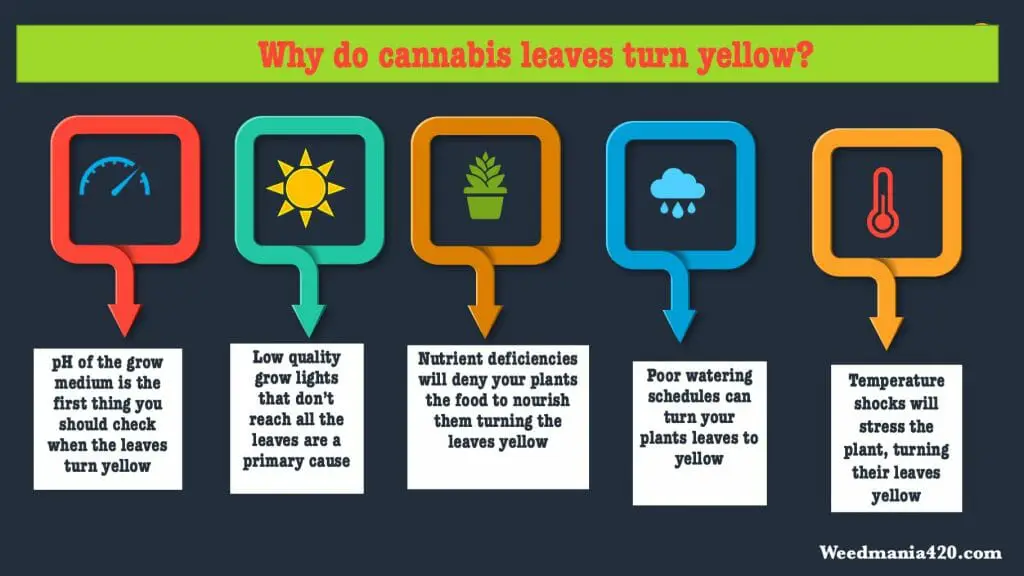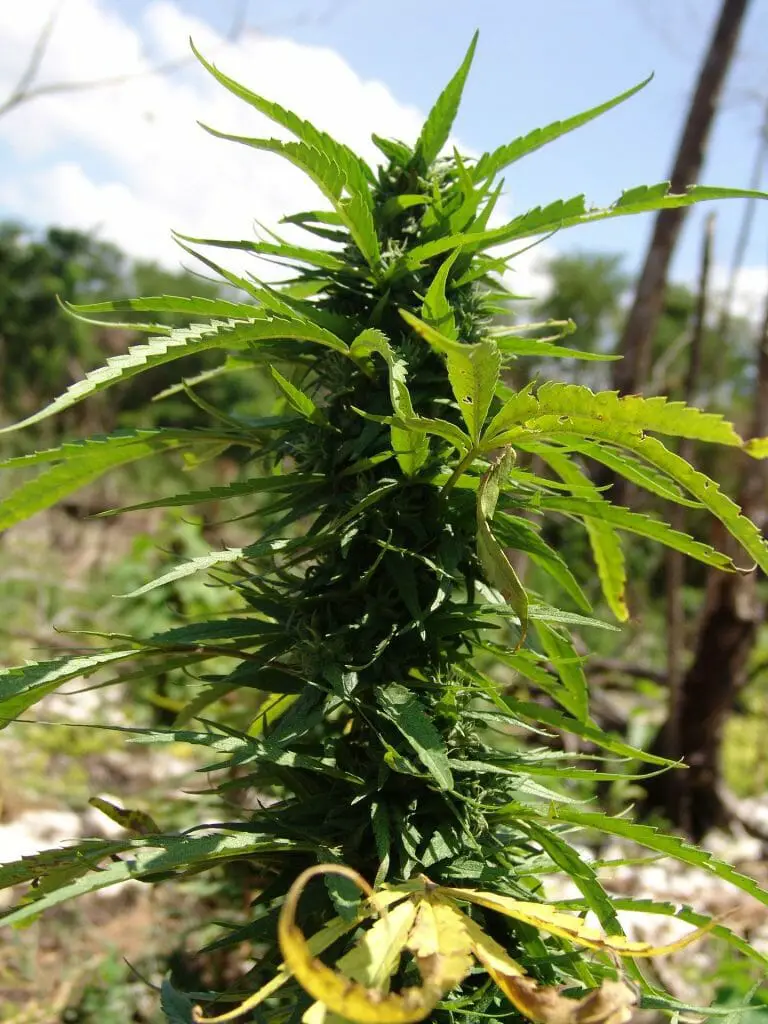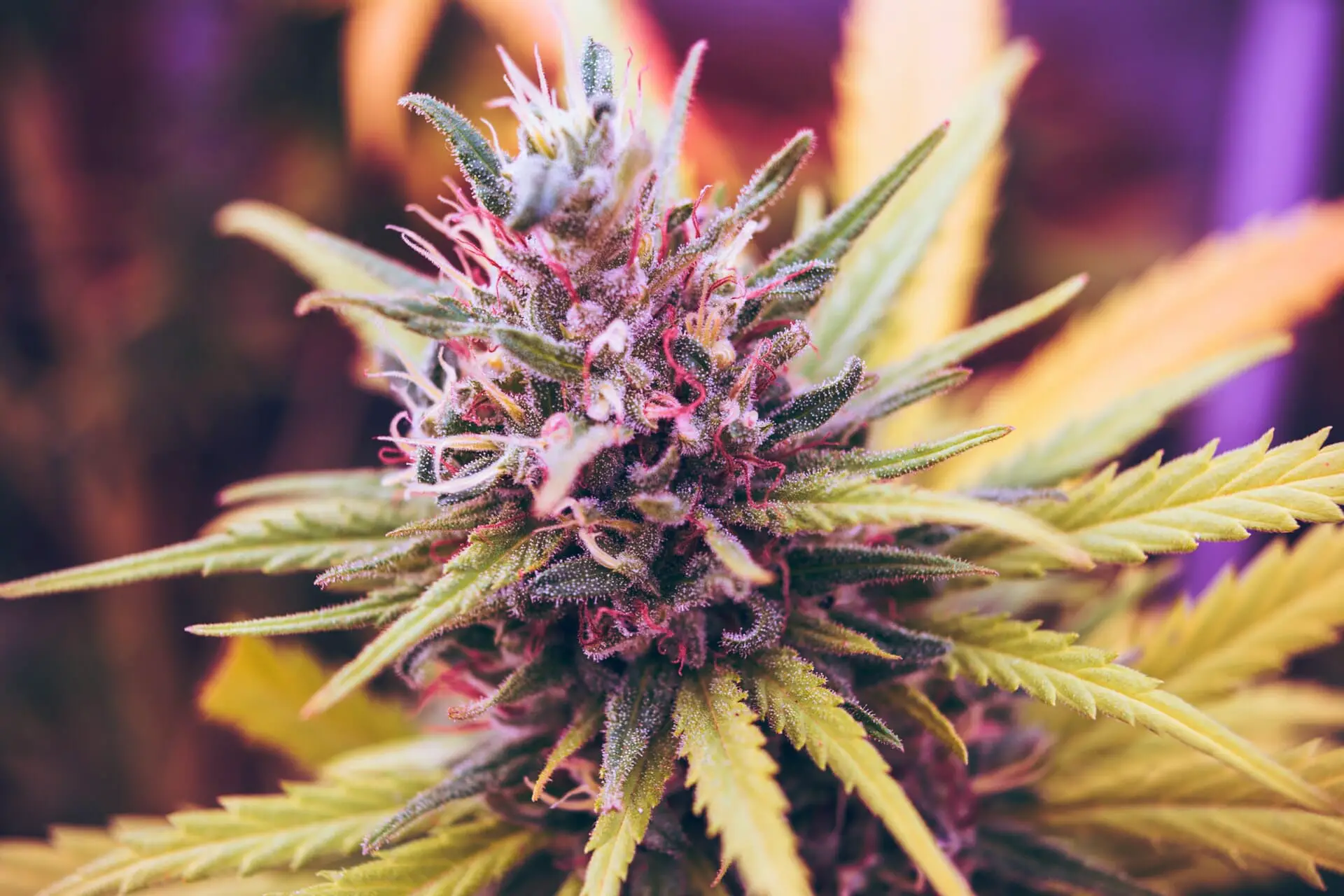Growing cannabis is fun. There’s no doubt about that. No feeling surpasses the bliss of seeing your pot plants grow into healthy buds. However, sometimes the leaves of your cannabis plants turn yellow, and you might not know what causes or how to deal with it.
Table of Contents
Why do cannabis leaves turn yellow?
The yellowing leaves can be frustrating, especially when you have done everything right: kept strict watering schedules, followed the right lighting cycles, trained the plants to improve exposure to the light, and feeding them the right nutrients at the right stages.
The cannabis leaves turn yellow because the plant is stressed. The stress might be a result of either nutrient deficiencies, poor watering schedules, poor lighting, or pH imbalance.
Sometimes the yellowing takes such a deep hue, and the plants begin being droopy that you might think your cannabis plant can’t be saved.
The good news is that you can save your plant, and also sometimes, you don’t even need to worry about the yellow leaf color.
In this article, let’s look at some of the reasons that cause the leaves to turn yellow, how to fix the problems, and when not to worry about the yellowing leaves.

Why should cannabis leaves be green?
A healthy cannabis plant leaves, just like other plants, are green because of the chlorophyll in them.
The leaves need this green pigment to help trap light energy and transform it into food through photosynthesis. Note that there are other color pigments in a plant’s leaves; the yellow and the orange carotenoids, layered under the green chlorophyll.
However, of all these other pigments, it’s only the green pigment that can transform the light into energy for plant growth and production.
Therefore, when your cannabis plant has most of its leaves yellowing, it maims its production process. The effect can be as subtle as late maturity, or as tragic as the death of the plant itself.
The extent of destruction depends on the stage of the plant when the yellowing hit hard and how long it takes to contain it.
What makes cannabis leaves turn yellow?
Different factors can cause the yellowing of cannabis leaves. To blanket it, the yellowness is mostly caused by strain on the plant’s part. The plant lacks something crucial, so mostly, when the leaves turn yellow, it is the plant’s way of telling you it is ailing.
Beginner growers term the yellowing leaves as the disease, but experienced cannabis growers know that it is a symptom of a much-hidden sickness that, if not diagnosed at the right time might maim, or even kill the plant.
Here are the common causes of cannabis leaves turning yellow;

High or low pH
When your cannabis leaves are yellowing, the place to begin is to test the pH of the grow medium.
The pH is a measure of acidity and alkalinity on a scale of range between 1-14. At 7, the pH is neutral; below it, the medium is acidic, and its concentrations aggravate towards 1. Beyond 7, the pH is alkaline.
Different grow mediums require varying levels of pH to guarantee the optimum growth of your cannabis plants.
For soil: maintain a pH of between 6-7.
For hydroponics: maintain a pH of between 5.5-6.2.
Keeping the pH in the range is essential in ensuring that your plants absorb the nutrients at their roots.
Any imbalance inhibits the absorption of nutrients and starves off the leaves, depleting the chlorophyll in the leaves hence revealing the yellow layer below the green pigment.
And while pH imbalance can affect your plants adversely, it gets worse because most growers misdiagnose it as nitrogen deficiency.
The misdiagnosis leads the grower to supplement the nitrogen, further causing nutrient burn— the plant gets too much nutrients at the roots that can’t be used by the plant because of nutrient lockout.
How to fix pH imbalance
Maintaining optimum pH ranges is essential for your cannabis plant health, but you don’t have to crack your mind. With the right tools, you can know the pH level of your grow medium and even know the concentration to add to it.
Use this pH measuring pen to gauge the right levels and the correct figures before you add nutrients.
How to adjust pH for your cannabis plants
The nutrients and supplements you use on your plants affect the level of pH. The base nutrients will lower the pH while other supplements will raise it. So, before you test the pH level, make sure that the supplements you use have infiltrated the grow medium. That way, you will get accurate figures.
To adjust pH, go for pH up and pH low products. Make sure the products are made specifically for pH as they allow significant pH adjustment with fewer concentrate doses.
They also don’t affect the effectiveness of other nutrient solutions you use on your plant. And while at it, only deal with the pH of the inflow solutions.
Most growers make the mistake of testing the pH of runoff solutions and use the figure to inform their pH adjustments of in-flow solutions. This will affect the pH stability of the nutrient solution in the root. Avoid runoff pH because it’s only the inflow pH that matters.
After adjusting pH, test again to make sure the levels are appropriate for your grow medium.
Poor watering schedules
Another major issue that causes yellowing of the cannabis leaves is either overwatering or underwatering.
Overwatering will make your plant leaves yellow and make them droopy— that’s a sign to look for when you doubt your watering schedules.
Overwatering your plants inhibits the flow of oxygen to the roots hence interferes with the metabolism of the nutrients, thus turning the leaves to yellow.
On the other hand, when underwatered, the leaves will be thin and frail because the plant doesn’t get enough water. If you don’t rectify this, the leaves will wilt, turn yellow, and dry.
How to fix watering problems
Fixing watering schedules is the simplest because your diagnosis will inform your next action. If your plant is overwatered, change your schedules and water less frequently. If your plants are underwatered, water them more regularly.
Poor lighting
While we all know how important light is to the plants, sometimes we make a mistake and subject the plant to low light. When the light is insufficient, the plant can’t make its food for growth and development. The leaves will then begin yellowing and stop growing.
Another common lighting problem is when the light source is too close to the top of the plant, thus causing light burn. Light burn causes the plant’s leaves to turn yellow and curl upwards. The leaves will look roasted because that’s what’s going to happen if you do nothing about it.
How to fix poor lighting
Use appropriate lights for your grow room. Don’t make the mistake of using low-intensity house bulbs; they’re insufficient. Instead, use HID lights, or when you care about cutting costs, LED lights.
Also, mind the distance between the light source and the top of your cannabis plants.
Move closer if the light source is weak and further if the light is scorching the plants’ top. Depending on the watt of your lights, keep your plant between 8-20 inches from the light source.
Trim the stems that might limit other leaves’ access to light. When other leaves can’t access the light because the top blocks the rest of the leaves, they turn yellow. Training is a process you must learn because it will be necessary, mostly at the vegetative stage.
Nutrient deficiencies
If you have done everything right; the leaves are neither droopy nor thin because the plants are well watered, the soil pH is within range, and the lighting source is adequate, then nutrient deficiency must be the culprit.
The first clue is to look at the section where the yellow leaves have grown from. If the yellow leaves are around the base, it a tell-tale sign of nutrient deficiency— mostly nitrogen, iron, magnesium, phosphorus, potassium, sulfur, or zinc.
How to fix nutrient deficiency in your cannabis plants
The easiest way to remedy nutrient deficiency is to get a fertilizer that’s specifically made for cannabis. If you can find one that has all the nutrients your plant lacks, the better.
When shopping for the fertilizers, choose the ones that have a higher nitrogen content. Go for NPK numbers that are higher at the beginning—N. Also, choose the right fertilizer for the stage of your plants.
You can also use organic living soils because it’s rich in nutrients and microbes that break down the nutrients for the plant’s use.
The biggest relief with organic living soil is that it reduces the need for supplements. It also gives you the peace of mind knowing that your plants can’t suffer a severe nutrient deficiency.
Extreme temperatures
Temperature is another primary culprit when it comes to discoloration of the cannabis leaves.
If the air circulation in your grow room is poor, your plants might suffer extremely high temperatures that will curl their leaves and turn their color to yellow.
Keep the temperatures between 18°C and 28°C for optimum development. Extreme cold or warm temperatures can kill your plants.
Do not just assume the temperatures; get real measurements from the closest thermometer to the plant. If you haven’t invested in one yet, try this thermometer from Amazon.
When you shouldn’t worry about cannabis leaves turning yellow
It’s true that weed doesn’t speak the human language and can only use the non-verbal cues like droopy leaves, wilting leaves, or leaves turning yellow, but sometimes, it sends a false alarm.
Or let’s just say that sometimes the yellowing of the leaves indicates that things are happening as they should. Here are situations when yellowing is no cause for alarm:
The first leaves falling off- The first leaves of cannabis are like baby teeth; they knock off naturally through the growth process. Before they fall, they turn yellow and tither, then bow in defeat as their life cycle comes to a natural end.
When the plants are ready for harvesting- When the plants are ready for harvesting, the leaves naturally turn to yellow. This should be no cause for alarm. They’re perfectly fine.
Mutations- Sometimes you notice some sections of the leaves are yellow, and it isn’t because they are sick, but because of mutations. The leaves will only be yellow but exhibit good health. Treat mutations as the natural appearance of your plants— ignore the yellow leaves.
In conclusion
Take a keen look at your plant’s leaves and note their health. From the information we have shared here, you will know the ailment your plant is enduring, its cause, and how to fix it.

